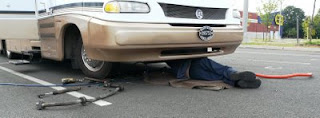
When you look at The Outer Banks on a map, there seems to be little more than a thin line of land kissing the sea. And so it is when you come here. There is so much water to the west and to the east that the land seems insignificant.
But the land is what makes the place so special.
We came to Hatteras Lighthouse and listened to a park ranger told us about the graveyard of the Atlantic, just off the Outer Banks. There are around 1,000 ships buried in the sands of Diamond Shoals. But this ranger very smartly focused on just one - a German U-boat. The submarine, numbered 701, cruised off the shoals and did some substantial damage to U.S. ships during 1942. She even headed up to the mouth of the Chesapeake Bay and, under the cloak of night, she laid out a field of mines that resulted in the sinking of three ships.
She cruised just under the waters of the Outer Banks and took out one of the largest fuel tankers of the time. But she sustained damage to her air scrubbing system that caused her crew of 50 to get sick from carbon dioxide poisoning. She had to make frequent trips to the surface to open her hatches and take in fresh air. And that was her undoing. A little trawler, outfitted poorly by the Navy, tried to take her out by throwing depth charges at her while she was on the surface.
Before she could dive, however, the trawler radioed to the mainland and a bomber was dispatched. It dropped two depth charges which blew her stern off and she sank in 100 feet of water. The skipper sent his men to the surface in a huge embolism of air from the submarine and 40 of the 50 men made it up. The bomber dropped them a raft before heading back to base. The Gulf Stream current took the men north, far from the site of the attack and all but seven men died while awaiting rescue. A seaplane landed in the Atlantic and saved the seven men, including the skipper.
We wandered the grounds of the lighthouse and learned the entire structure had been moved more than a half mile in 1999 when its original position was threatened by the encroaching Atlantic. Moving this huge lighthouse - which weighed twice what a Space Shuttle weighs - was accomplished with jacks and tractors.
We headed on down the ribbon of land to a free ferry that took us and our car to Ocracoke Island. Free! Now this is an interesting change of attitude, compared to the Maine ferry system which is designed to discourage visitors from visiting the beautiful islands off the Maine coast by more than doubling the fare charged if you buy a round-trip ticket on the mainland compared to the local residents' cost if they buy their tickets on the islands. Mmmmm. It says much about welcoming people.
Ocracoke is a distinctive little place about 14 miles long with hour-glass-fine sand. The wind howled and blew the sand into every orifice and crevice on us. And we were astonished to see people driving their trucks on the beaches of the main part of the Outer Banks where the land seemed to be invisible because it was so low. That's what our picture at the top of this blog shows.
On our way out, the wind had picked up even more. The road was covered with drifting sand and even salt water that had blown over the dunes from the nearby Atlantic. Great fluff balls of foam filled the road, the spindrift of the seas. Highway workers pushed back the sand and we crept through the one road out with salt water up to our tires.


